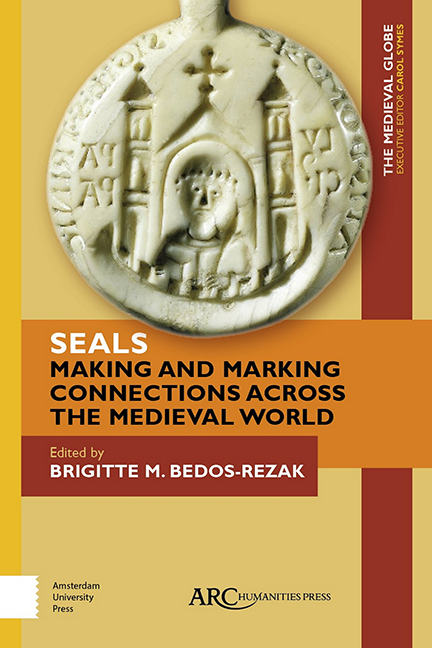Book contents
- Frontmatter
- Contents
- List of Illustrations
- Acknowledgements
- Cultural Transactions: An Introduction to Medieval Seals from a Global Perspective
- Seals as Conceptual and Ritual Tools in Chinese Buddhism, ca. 600– 1000 CE
- Imprinting Powers: The Astrological Seal and Its Doctrinal Meanings in the Latin West
- A Medieval Solution to an Early Modern Problem? The Royal Animal Seals of Jambi
- Expressing New Rule: Seals from Early Islamic Egypt and Syria, 600– 800 CE
- The Formulation of Urban Identity on Byzantine Seals
- The Cloth Seal: A Mark of Quality, Identification, or Taxation?
- Archaeology and Sigillography in Northern Europe
- Medieval Treaties and the Diplomatic Aesthetic
- Index
The Formulation of Urban Identity on Byzantine Seals
Published online by Cambridge University Press: 20 November 2020
- Frontmatter
- Contents
- List of Illustrations
- Acknowledgements
- Cultural Transactions: An Introduction to Medieval Seals from a Global Perspective
- Seals as Conceptual and Ritual Tools in Chinese Buddhism, ca. 600– 1000 CE
- Imprinting Powers: The Astrological Seal and Its Doctrinal Meanings in the Latin West
- A Medieval Solution to an Early Modern Problem? The Royal Animal Seals of Jambi
- Expressing New Rule: Seals from Early Islamic Egypt and Syria, 600– 800 CE
- The Formulation of Urban Identity on Byzantine Seals
- The Cloth Seal: A Mark of Quality, Identification, or Taxation?
- Archaeology and Sigillography in Northern Europe
- Medieval Treaties and the Diplomatic Aesthetic
- Index
Summary
THE WORLD OF the ancient Mediterranean was characterized, over centuries, by a large number of cities with a high degree of autonomy. In late antiquity, however, the typical Greco-Roman polis experienced a constant decline, and, under the influence of invasion by other ethnic groups, in particular with the Slavic migration into the Balkans and conflicts with Persians and Arabs, most cities changed from poleis to being kastra (fortified inhabited sites). By the middle of the seventh century the eastern Roman (Byzantine) Empire was extensively de-urbanized. Besides Constantinople, only a few cities (such as Thessaloniki, Ephesus, and Trebizond) were able to preserve traditional urban characteristics. This development resulted in fundamental changes to cities’ administrative, economic, and social structures.
From the tenth century on, however, cities gradually took on economic and cultural functions again. A self-confident aristocracy formed in these cities, playing an influential part in local politics and stimulating economic development by engaging in commercial production and trade (as has been shown for Rhaidestos, Thebes, and Monemvasia, among others). In addition, members of the cities’ upper classes increasingly concerned themselves with the social and cultural interests of the society. Religious lay brotherhoods, which formed in the middle of the eleventh century, not only administered religious cults and organized processions but— more importantly— provided reciprocal care. They also performed the commemoration of the dead, thereby making the increasing socio-economic stratification of the city visible (as in the well-documented case of Thebes).
Yet, in contrast to western Europe— where, after the turn of the second millennium, some cities attained substantial military and economic strength and, in the form of communes, eventually achieved legal and administrative independence— Byzantine cities never developed into similarly independent self-governing communities or city states. Although some cities (such as Larissa, Amaseia, Adrianople, and Thessaloniki) created their own legal customs and elements of a civic organization, ranging from civic institutions with designated responsibilities to peoples’ assemblies and councils, which are assumed to have acted alongside the state representatives, this does not indicate that these cities reached any real civic autonomy. It is important to establish, however, that Byzantine cities and their inhabitants did develop a distinctive civic culture and, to some extent, a civic consciousness, based upon growing economic and military power and the existence of local cults.
- Type
- Chapter
- Information
- Seals - Making and Marking Connections across the Medieval World , pp. 149 - 166Publisher: Amsterdam University PressPrint publication year: 2019



